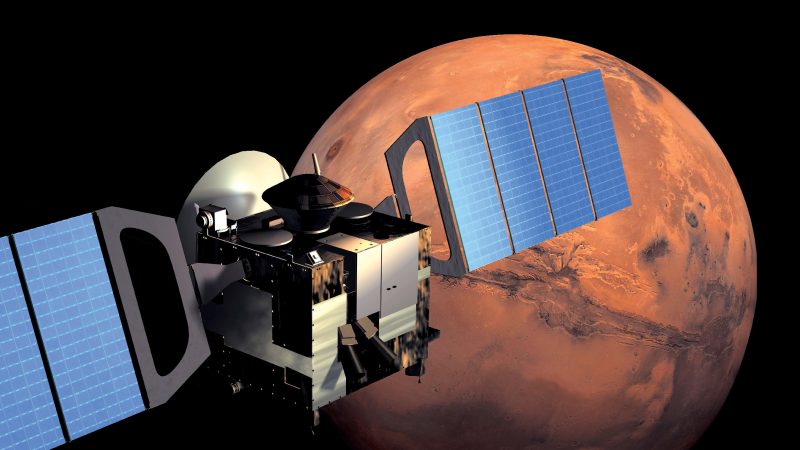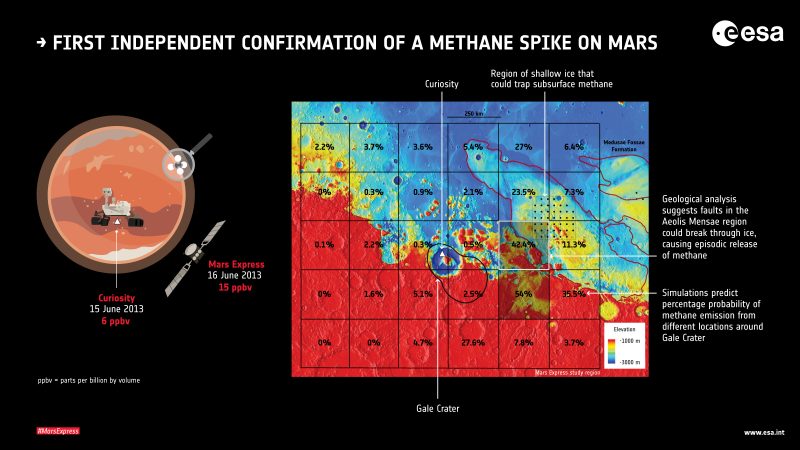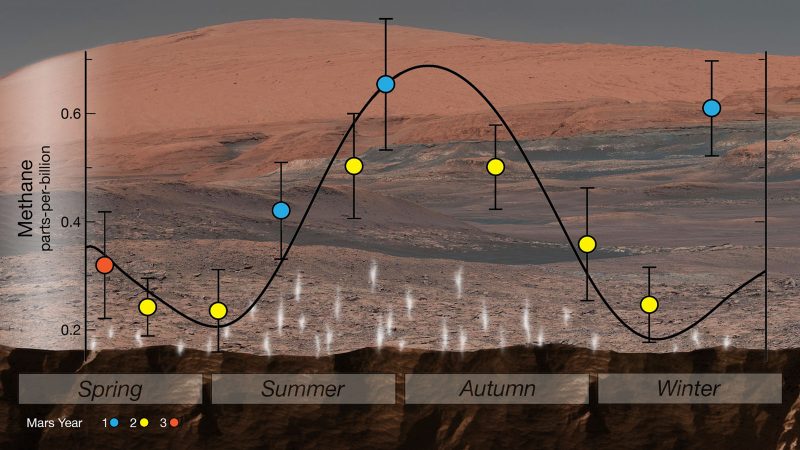

Artist’s conceptof Mars Express in orbit around Mars. New analysis of data from the spacecraft has independently confirmed the first detection of methane by NASA’s Curiosity rover in 2013. Image via DLR Institute of Planetary Research.
Where does Mars’ methane come from? That is one of the most intriguing mysteries for Mars scientists in recent years. Could Mars’ methane be evidence of … life?
Now, there is a correlated confirmation of one significant detection of methane. It’s the first time an in-situ measurement has been independently confirmed from orbit. Since landing in 2012, NASA’s Curiosity rover has at times detected methane in Mars’ atmosphere. The new study – led by Marco Giuranna from the National Institute for Astrophysics and the Institute for Space Astrophysics and Planetology in Rome, Italy – confirms that ESA’s Mars Express orbiter detected a June 2013 methane spike the day after Curiosity. The peer-reviewed finding was reported in Nature Geoscience on April 1, 2019. According to Dmitri Titov, ESA’s Mars Express project scientist:
Mars Express was the first to report a significant detection of methane from orbit around Mars, and now, 15 years later, we can announce the first simultaneous and co-located detection of methane with a rover on the surface.
Why is methane on Mars so interesting to scientists? Writing in Science last year, Eric Hand called this gas the effluvia of life, mainly because some 16 percent of Earth’s annual methane emissions to the atmosphere come from the belches of cows. ESA explained:
The molecule attracts such attention because on Earth methane is generated by living organisms, as well as geological processes. Because it can be destroyed quickly by atmospheric processes, any detection of the molecule in the Martian atmosphere means it must have been released relatively recently – even if the methane itself was produced millions or billions of years ago and lay trapped in underground reservoirs until now.
While spacecraft and telescopic observations from Earth have in general reported no or very low detections of methane, or measurements right at the limit of the instruments’ capabilities, a handful of spurious spikes, along with Curiosity’s reported seasonal variation at its location in Gale Crater, raise the exciting question of how it is being generated and destroyed in present times.
The June 2013 spike seen by Curiosity was about six ppb (parts per billion), while the Mars Express detection the day after measured about 15 ppb. That is very small in comparison to methane levels in Earth’s atmosphere, but still significant. By comparison, the background levels of methane in Gale Crater [where Curiosity is exploring on Mars] tend to range from 0.24 ppb to 0.65 ppb. From the paper:
Reports of methane detection in the Martian atmosphere have been intensely debated. The presence of methane could enhance habitability and may even be a signature of life. However, no detection has been confirmed with independent measurements. Here, we report a firm detection of 15.5 ± 2.5 ppb by volume of methane in the Martian atmosphere above Gale Crater on 16 June 2013, by the Planetary Fourier Spectrometer onboard Mars Express, one day after the in-situ observation of a methane spike by the Curiosity rover. Methane was not detected in other orbital passages. The detection uses improved observational geometry, as well as more sophisticated data treatment and analysis, and constitutes a contemporaneous, independent detection of methane. We perform ensemble simulations of the Martian atmosphere … to identify a potential source region east of Gale Crater. Our independent geological analysis also points to a source in this region, where faults of Aeolis Mensae may extend into proposed shallow ice of the Medusae Fossae Formation and episodically release gas trapped below or within the ice. Our identification of a probable release location will provide focus for future investigations into the origin of methane on Mars.

Grid of region around Gale Crater where the methane is most likely to originate, according to the new study. Image via ESA/Giuranna et al. (2019).
Although the results from Curiosity stood on their own, the additional confirmation from Mars Express further solidifies the finding and helps to narrow down the location where the methane spike originated, as Giuranna explained:
In general we did not detect any methane, aside from one definite detection of about 15 parts per billion by volume of methane in the atmosphere, which turned out to be a day after Curiosity reported a spike of about six parts per billion.
Although parts per billion in general means a relatively small amount, it is quite remarkable for Mars – our measurement corresponds to an average of about 46 tonnes of methane [51 U.S. tons] that was present in the area of 49,000 square kilometers [19,000 sq miles] observed from our orbit.
So, both a rover and an orbiter confirmed the methane spike, but where did it come from? The Curiosity team speculated at the time that it came from somewhere just north of the rover, but still inside Gale Crater, where the rover has been since 2012. But the new analysis indicates it more likely came from outside the crater, about 310 miles (500 km) to the east. According to Giuranna:
Our new Mars Express data, taken one day after Curiosity’s recording, change the interpretation of where the methane originated from, especially when considering global atmospheric circulation patterns together with the local geology. Based on geological evidence and the amount of methane that we measured, we think that the source is unlikely to be located within the crater.

Illustration depicting what processes could create and destroy methane on Mars. The methane most likely originates from below the surface and is released into the atmosphere through subsurface cracks. Image via ESA.
Two independent analyses came to the same conclusion. The region around Gale Crater was divided into grids of 250 square kilometers [96 sq miles] to narrow down the location of the spike.
Researchers from the Royal Belgian Institute for Space Aeronomy (BIRA-IASB) in Brussels, Belgium, conducted the first analysis, using computer simulations to create one million possible emission scenarios for each square, in order to predict the probability of methane emission for each of those locations. The simulations were comprehensive, taking into account the measured data, expected atmospheric circulation patterns and methane release intensity and duration based on the geological phenomenon of “gas seepage.”
Geologists from the National Institute of Geophysics and Volcanology in Rome, Italy, and the Planetary Science Institute in Tucson, Arizona, did the second analysis. This one focused on identifying physical features in the terrain that could be associated with methane seepage from below the surface. Such features are common on Earth, including tectonic faults, mud volcanoes and natural gas fields. According to co-author Giuseppe Etiope:
We identified tectonic faults that might extend below a region proposed to contain shallow ice. Since permafrost is an excellent seal for methane, it is possible that the ice here could trap subsurface methane and release it episodically along the faults that break through this ice.
Remarkably, we saw that the atmospheric simulation and geological assessment, performed independently of each other, suggested the same region of provenance of the methane. This is very exciting and largely unexpected.

Diagram depicting seasonal variation in amount of methane detected by the Curiosity rover, peaking in warmer months. Image via NASA/JPL-Caltech.
Periodic or intermittent releases of methane from sources like these would fit with observations from various telescopes and spacecraft over the years. Co-author Frank Daerden added:
Our results support the idea that methane release on Mars might be characterized by small, transient geological events rather than a constantly replenishing global presence, but we also need to understand better how methane is removed from the atmosphere, and how to reconcile the Mars Express data with results from other missions.
Scientists have theorized that the most likely source of the methane would be from underground, and these results seem to support that. Pockets of methane could be released periodically by such small geological events. Curiosity had also determined that the methane releases near its location were seasonal, apparently associated with periods of warming temperatures in summer, which small bursts of trapped methane being released by warming ice deposits might explain.

NASA’s Curiosity rover detected spikes in the level of methane in the atmosphere in 2013 and 2014. ESA’s Mars Express orbiter also re-confirmed the first of those findings. Image via NAS/JPL-Caltech.
Finding the location of at least one methane spike is significant, but it doesn’t tell us how the methane was created in the first place. On Earth, living organisms produce the vast majority of methane, including underground. It can also originate from geological activity, however. Does life also produce Mars’ methane – most likely microbes – or geology? We don’t know yet, and only further observations will help to answer that question. There is also still the question of what causes the methane to disappear again so quickly. Meanwhile, the analysis of the sources of the methane will continue, as noted by Giuranna:
We will re-analyze more of the data collected by our instrument in the past, while continuing our ongoing monitoring efforts, including coordinating some observations with the ExoMars Trace Gas Orbiter.
The Trace Gas Orbiter (TGO) – part of ESA’s ExoMars mission – unexpectedly found no methane during its first studies of the Martian atmosphere, but it is possible that it just wasn’t looking at the right time, since the bursts of methane do seem to be seasonal in nature. Hopefully upcoming observations will be more successful – the spacecraft carries some of the most advanced instruments designed to analyze methane and other trace gases.
Bottom line: The origin of Mars’ methane is one of the most intriguing mysteries of the red planet. We still don’t know if the methane is geological or biological – or perhaps even both – but thanks to new data from Mars Express and Curiosity, we are now starting to close in on just where the methane is coming from – an important step toward determining just what is creating it.
Source: Independent confirmation of a methane spike on Mars and a source region east of Gale Crater
from EarthSky http://bit.ly/2D27HAa


Artist’s conceptof Mars Express in orbit around Mars. New analysis of data from the spacecraft has independently confirmed the first detection of methane by NASA’s Curiosity rover in 2013. Image via DLR Institute of Planetary Research.
Where does Mars’ methane come from? That is one of the most intriguing mysteries for Mars scientists in recent years. Could Mars’ methane be evidence of … life?
Now, there is a correlated confirmation of one significant detection of methane. It’s the first time an in-situ measurement has been independently confirmed from orbit. Since landing in 2012, NASA’s Curiosity rover has at times detected methane in Mars’ atmosphere. The new study – led by Marco Giuranna from the National Institute for Astrophysics and the Institute for Space Astrophysics and Planetology in Rome, Italy – confirms that ESA’s Mars Express orbiter detected a June 2013 methane spike the day after Curiosity. The peer-reviewed finding was reported in Nature Geoscience on April 1, 2019. According to Dmitri Titov, ESA’s Mars Express project scientist:
Mars Express was the first to report a significant detection of methane from orbit around Mars, and now, 15 years later, we can announce the first simultaneous and co-located detection of methane with a rover on the surface.
Why is methane on Mars so interesting to scientists? Writing in Science last year, Eric Hand called this gas the effluvia of life, mainly because some 16 percent of Earth’s annual methane emissions to the atmosphere come from the belches of cows. ESA explained:
The molecule attracts such attention because on Earth methane is generated by living organisms, as well as geological processes. Because it can be destroyed quickly by atmospheric processes, any detection of the molecule in the Martian atmosphere means it must have been released relatively recently – even if the methane itself was produced millions or billions of years ago and lay trapped in underground reservoirs until now.
While spacecraft and telescopic observations from Earth have in general reported no or very low detections of methane, or measurements right at the limit of the instruments’ capabilities, a handful of spurious spikes, along with Curiosity’s reported seasonal variation at its location in Gale Crater, raise the exciting question of how it is being generated and destroyed in present times.
The June 2013 spike seen by Curiosity was about six ppb (parts per billion), while the Mars Express detection the day after measured about 15 ppb. That is very small in comparison to methane levels in Earth’s atmosphere, but still significant. By comparison, the background levels of methane in Gale Crater [where Curiosity is exploring on Mars] tend to range from 0.24 ppb to 0.65 ppb. From the paper:
Reports of methane detection in the Martian atmosphere have been intensely debated. The presence of methane could enhance habitability and may even be a signature of life. However, no detection has been confirmed with independent measurements. Here, we report a firm detection of 15.5 ± 2.5 ppb by volume of methane in the Martian atmosphere above Gale Crater on 16 June 2013, by the Planetary Fourier Spectrometer onboard Mars Express, one day after the in-situ observation of a methane spike by the Curiosity rover. Methane was not detected in other orbital passages. The detection uses improved observational geometry, as well as more sophisticated data treatment and analysis, and constitutes a contemporaneous, independent detection of methane. We perform ensemble simulations of the Martian atmosphere … to identify a potential source region east of Gale Crater. Our independent geological analysis also points to a source in this region, where faults of Aeolis Mensae may extend into proposed shallow ice of the Medusae Fossae Formation and episodically release gas trapped below or within the ice. Our identification of a probable release location will provide focus for future investigations into the origin of methane on Mars.

Grid of region around Gale Crater where the methane is most likely to originate, according to the new study. Image via ESA/Giuranna et al. (2019).
Although the results from Curiosity stood on their own, the additional confirmation from Mars Express further solidifies the finding and helps to narrow down the location where the methane spike originated, as Giuranna explained:
In general we did not detect any methane, aside from one definite detection of about 15 parts per billion by volume of methane in the atmosphere, which turned out to be a day after Curiosity reported a spike of about six parts per billion.
Although parts per billion in general means a relatively small amount, it is quite remarkable for Mars – our measurement corresponds to an average of about 46 tonnes of methane [51 U.S. tons] that was present in the area of 49,000 square kilometers [19,000 sq miles] observed from our orbit.
So, both a rover and an orbiter confirmed the methane spike, but where did it come from? The Curiosity team speculated at the time that it came from somewhere just north of the rover, but still inside Gale Crater, where the rover has been since 2012. But the new analysis indicates it more likely came from outside the crater, about 310 miles (500 km) to the east. According to Giuranna:
Our new Mars Express data, taken one day after Curiosity’s recording, change the interpretation of where the methane originated from, especially when considering global atmospheric circulation patterns together with the local geology. Based on geological evidence and the amount of methane that we measured, we think that the source is unlikely to be located within the crater.

Illustration depicting what processes could create and destroy methane on Mars. The methane most likely originates from below the surface and is released into the atmosphere through subsurface cracks. Image via ESA.
Two independent analyses came to the same conclusion. The region around Gale Crater was divided into grids of 250 square kilometers [96 sq miles] to narrow down the location of the spike.
Researchers from the Royal Belgian Institute for Space Aeronomy (BIRA-IASB) in Brussels, Belgium, conducted the first analysis, using computer simulations to create one million possible emission scenarios for each square, in order to predict the probability of methane emission for each of those locations. The simulations were comprehensive, taking into account the measured data, expected atmospheric circulation patterns and methane release intensity and duration based on the geological phenomenon of “gas seepage.”
Geologists from the National Institute of Geophysics and Volcanology in Rome, Italy, and the Planetary Science Institute in Tucson, Arizona, did the second analysis. This one focused on identifying physical features in the terrain that could be associated with methane seepage from below the surface. Such features are common on Earth, including tectonic faults, mud volcanoes and natural gas fields. According to co-author Giuseppe Etiope:
We identified tectonic faults that might extend below a region proposed to contain shallow ice. Since permafrost is an excellent seal for methane, it is possible that the ice here could trap subsurface methane and release it episodically along the faults that break through this ice.
Remarkably, we saw that the atmospheric simulation and geological assessment, performed independently of each other, suggested the same region of provenance of the methane. This is very exciting and largely unexpected.

Diagram depicting seasonal variation in amount of methane detected by the Curiosity rover, peaking in warmer months. Image via NASA/JPL-Caltech.
Periodic or intermittent releases of methane from sources like these would fit with observations from various telescopes and spacecraft over the years. Co-author Frank Daerden added:
Our results support the idea that methane release on Mars might be characterized by small, transient geological events rather than a constantly replenishing global presence, but we also need to understand better how methane is removed from the atmosphere, and how to reconcile the Mars Express data with results from other missions.
Scientists have theorized that the most likely source of the methane would be from underground, and these results seem to support that. Pockets of methane could be released periodically by such small geological events. Curiosity had also determined that the methane releases near its location were seasonal, apparently associated with periods of warming temperatures in summer, which small bursts of trapped methane being released by warming ice deposits might explain.

NASA’s Curiosity rover detected spikes in the level of methane in the atmosphere in 2013 and 2014. ESA’s Mars Express orbiter also re-confirmed the first of those findings. Image via NAS/JPL-Caltech.
Finding the location of at least one methane spike is significant, but it doesn’t tell us how the methane was created in the first place. On Earth, living organisms produce the vast majority of methane, including underground. It can also originate from geological activity, however. Does life also produce Mars’ methane – most likely microbes – or geology? We don’t know yet, and only further observations will help to answer that question. There is also still the question of what causes the methane to disappear again so quickly. Meanwhile, the analysis of the sources of the methane will continue, as noted by Giuranna:
We will re-analyze more of the data collected by our instrument in the past, while continuing our ongoing monitoring efforts, including coordinating some observations with the ExoMars Trace Gas Orbiter.
The Trace Gas Orbiter (TGO) – part of ESA’s ExoMars mission – unexpectedly found no methane during its first studies of the Martian atmosphere, but it is possible that it just wasn’t looking at the right time, since the bursts of methane do seem to be seasonal in nature. Hopefully upcoming observations will be more successful – the spacecraft carries some of the most advanced instruments designed to analyze methane and other trace gases.
Bottom line: The origin of Mars’ methane is one of the most intriguing mysteries of the red planet. We still don’t know if the methane is geological or biological – or perhaps even both – but thanks to new data from Mars Express and Curiosity, we are now starting to close in on just where the methane is coming from – an important step toward determining just what is creating it.
Source: Independent confirmation of a methane spike on Mars and a source region east of Gale Crater
from EarthSky http://bit.ly/2D27HAa

Aucun commentaire:
Enregistrer un commentaire